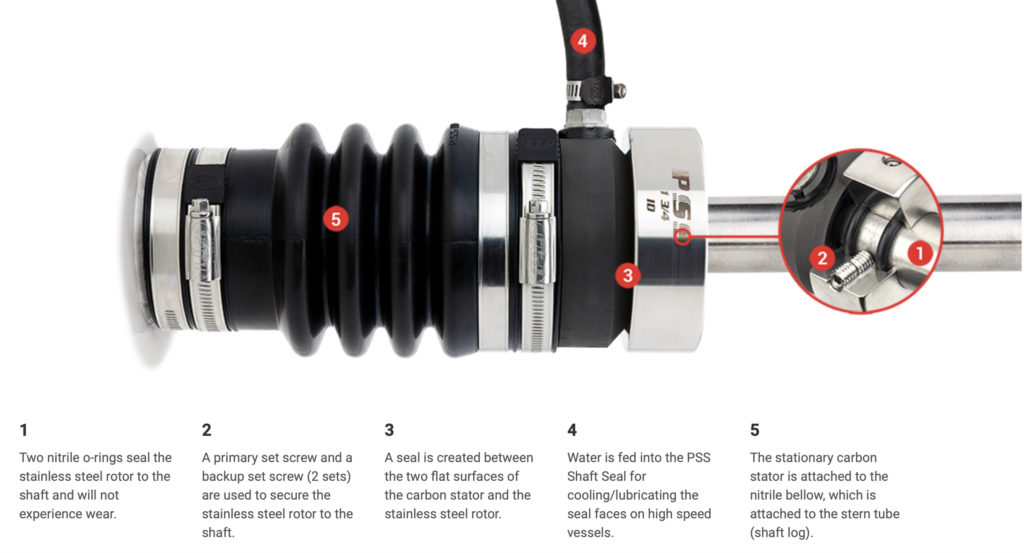Dripless Shaft Seals - Best Practices
By Van Helker
Helmsman Trawlers® are equipped with dripless shaft seals to keep water from entering the bilge where the shaft exits the hull through the stern tube / shaft log. These shaft seals usually offer reliable performance with relatively little maintenance; however, some best operating practices can maximize your time cruising and minimize your time in the yard. The Helmsman Trawlers 37, 38/38E, and 43 use the Packless Sealing System (PSS) Shaft Seal manufactured by PYI. The 31 uses a similar product manufactured by Eliche Radice. This article is relevant to both varieties of seals – though specifically pertains to the PSS.
The PSS maintains a watertight seal by means of a graphite flange that is firmly pressed against a rotating stainless-steel collar (attached to the shaft) by a spring-loaded bellows affixed to the end of the stern tube. A small water line originating from the engine raw water pump (on some boats it originates from the engine cooling water exhaust elbow) provides water flow and cooling to the shaft seal and the cutless bearings within the stern tube. This water flow is not essential to the operation of the PSS at speeds less than 12 knots, but it does provide the benefit of displacing any air in the stern tube with water, which is essential to lubricate and cool the cutless bearing.

I recently received a report from the owner of a Helmsman Trawlers 38 who had hauled his boat out for some routine boatyard work. Prior to haul out, his boat functioned normally but after being returned to the water the owner experienced, after some delay, considerable noise and vibration while underway. He first suspected the engine but eventually determined that the sound/vibration was associated with shaft rotation. After troubleshooting it was determined that air became trapped in the stern tube after all the water drained out during the haul out. This air block prevented cooling and lubrication of the cutless bearings and the shaft seal, and led to the overheating and destruction of the upper and lower cutless bearings and damage to the shaft seal. This necessitated a return trip to the boatyard for repairs. Further troubleshooting showed that the water supply line to the PSS had become blocked by scale and no water was flowing into the stern tube.
Fortunately, there is an easy way to prevent this type of incident, even in the absence of water flow to the PSS, by “burping” the air out manually. The PSS can be manually burped by pulling the carbon flange aft and away from the stainless-steel collar. This will break the seal and allow any trapped air out of the stern tube, allowing water into the shaft tube and eventually filling the shaft tube completely.
The “Burping” Method
While the shaft is stationary, pull aft on the carbon stator separating it from the stainless steel rotor. Pull back until water gushes out – you want to see more than a dribble to ensure that all of the air has been vented from the stern tube.
This action should be an item on every Helmsman Trawlers owner’s checklist as soon as their boat is returned to the water following a haul out – before starting the engine. Even in the event of a blockage to water flow the presence of water in the stern tube will be sufficient to provide the cooling and water lubrication necessary to prevent damage. It would also be prudent to inspect the water flow rates fed to the PSS periodically and address any blockages.
PYI recommends inspecting the PSS at least every six months, and any components showing signs of deterioration should be replaced. The bellows should be replaced every six years. For a full list of manufacturer recommendations visit the product website.


